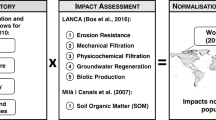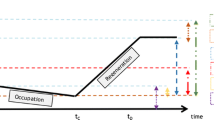Abstract
Purpose
To assess the diverse environmental impacts of land use, a standardization of quantifying land use elementary flows is needed in life cycle assessment (LCA). The purpose of this paper is to propose how to standardize the land use classification and how to regionalize land use elementary flows.
Materials and methods
In life cycle inventories, land occupation and transformation are elementary flows providing relevant information on the type and location of land use for land use impact assessment. To find a suitable land use classification system for LCA, existing global land cover classification systems and global approaches to define biogeographical regions are reviewed.
Results and discussion
A new multi-level classification of land use is presented. It consists of four levels of detail ranging from very general global land cover classes to more refined categories and very specific categories indicating land use intensities. Regionalization is built on five levels, first distinguishing between terrestrial, freshwater, and marine biomes and further specifying climatic regions, specific biomes, ecoregions and finally indicating the exact geo-referenced information of land use. Current land use inventories and impact assessment methods do not always match and hinder a comprehensive assessment of land use impact. A standardized definition of land use types and geographic location helps to overcome this gap and provides the opportunity to test the optimal resolution of land cover types and regionalization for each impact pathway.
Conclusions and recommendation
The presented approach provides the necessary flexibility to providers of inventories and developers of impact assessment methods. To simplify inventories and impact assessment methods of land use, we need to find archetypical situations across impact pathways, land use types and regions, and aggregate inventory entries and methods accordingly.

Similar content being viewed by others
References
Abell R, Thieme M, Revenga C, Bryer M, Kottelat M, Bogutskaya N, Coad B, Mandrak N, Balderas S, Bussing W (2008) Freshwater ecoregions of the world: a new map of biogeographic units for freshwater biodiversity conservation. BioScience 58:403–414
Alkemade R, van Oorschot M, Miles L, Nellemann C, Bakkenes M, ten Brink B (2009) GLOBIO3: a framework to investigate options for reducing global terrestrial biodiversity loss. Ecosystems 12:374–390
Arino O, Gross D, Ranera F, Leroy M, Bicheron P, Brockman C, Defourny P, Vancutsem C, Achard F, Durieux L, Bourg L, Latham J, Gregorio AD, Witt R, Herold M, Sambale J, Plummer S, Weber J (2007) GlobCover: ESA service for global land cover from MERIS. Geoscience and Remote Sensing Symposium, 2412-2415
Bartholomé E, Belward AS (2005) GLC2000: a new approach to global land cover mapping from Earth observation data. Int J Remote Sens 26:1959–1977
Beck T, Bos U, Wittstock B, Baitz M, Fischer M, Sedlbauer K (2010) LANCA—land use indicator value calculation in life cycle assessment. Fraunhofer, Stuttgart
de Schryver A, Goedkoop M (2008) Impact of land use in M. Goedkoop , R. Heijungs, M. Huijbregts, A. De Schryver, J. Struijs, R. van Zelm, eds. ReCiPe. A life cycle impact assessment method which comprises harmonised category indicatorsat the midpoint and the endpoint level, Online at http://www.lcia-recipe.net/@api/deki/files/11/=ReCiPe_main_report_final_27-02-2009_web.pdf
Di Gregorio A, Jansen LJM (2005) Land Cover Classification System (LCCS) classification concepts and user manual. Environment and Natural Resources Service (SDRN), Food and Agricultura Organisation of the United Nations, Rome
European Environmental Agency (2000) CORINE Land Cover. European Environmental Agency, Luxembourg
Frischknecht R, Jungbluth N (eds) (2007) Ecoinvent: overview and methodology. Swiss Centre for Life Cycle Inventories, Duebendorf
Giri C, Zhu Z, Reed B (2005) A comparative análisis of the Global Land Cover 2000 and MODIS land cover data sets. Remote Sens Environ 94:123–132
Holdridge LR (1947) Determination of world plant formations from simple climatic data. Science 105:367–368
Koellner T (2003) Land use in product life cycles and ecosystem quality. Peter Lang, Bern, Frankfurt a. M., New York
Koellner T, Scholz R (2008a) Assessment of land use impacts on the natural environment. Part 2: Generic characterization factors for local species diversity in Central Europe. Int J Life Cycle Assess 13:32–48
Koellner T, Scholz RW (2008b) Assessment of land use impacts on the natural environment. Appendix: CORINE Plus land-cover definitions. Int J Life Cycle Assess 13:48-1–48-3
Koellner T, de Baan L, Beck T, Brandão M, Civit B, Margni M, Milà i Canals L, Saad R, Maia de Souza D, Müller-Wenk R (2012) UNEP-SETAC guideline on global land use impact assessment on biodiversity and ecosystem services in LCA. Int J Life Cycle Assess (this issue)
Latifovic R, Zhu ZL, Cihlar J, Giri C, Olthof I (2004) Land cover mapping of North and Central America—global land cover 2000. Remote Sens Environ 89:116–127
Milà i Canals L, Bauer C, Depestele J, Dubreuil A, Freiermuth Knuchel R, Gaillard G, Michelsen O, Müller-Wenk R, Rydgren B (2007) Key elements in a framework for land use impact assessment within LCA. Int J Life Cycle Assess 12. doi:5
Müller-Wenk R, Brandão M (2010) Climatic impact of land use in LCA—carbon transfers between vegetation/soil and air. Int J Life Cycle Assess 15:172–182
Olson DM, Dinerstein E (1998) The global 200: a representation approach to conserving the Earth's most biologically valuable ecoregions. Conserv Biol 12:502–515
Olson DM, Dinerstein E, Wikramanayake ED, Burgess ND, Powell GVN, Underwood EC, D'Amico JA, Itoua I, Strand HE, Morrison JC, Loucks CJ, Allnutt TF, Ricketts TH, Kura Y, Lamoreux JF, Wettengel WW, Hedao P, Kassem KR (2001) Terrestrial ecoregions of the worlds: a new map of life on Earth. BioScience 51:933–938
Spalding MD, Fox HE, Halpern BS, McManus MA, Molnar J, Allen GR, Davidson N, Jorge ZA, Lombana AL, Lourie SA, Martin KD, McManus E, Molnar J, Recchia CA, Robertson J (2007) Marine ecoregions of the world: a bioregionalization of coastal and shelf areas. Bioscience 57:573–583
Weidema B, Bauer C, Hischier R, Mutel C, Nemecek T, Vadenbo CO, Wernet G (2011) Overview and methodology. Data quality guideline for the ecoinvent database version 3. Ecoinvent Report 1(v3). The ecoinvent Centre, St. Gallen
Acknowledgments
The authors wish to thank the UNEP/SETAC Life Cycle Initiative for the financial support of this work under the project Operational Characterization Factors for Land Use Impacts on Biodiversity and Ecosystem Services in the Life-Cycle Impact Assessment (LULCIA). The research was partly funded by the European Commission under the seventh framework program on environment; ENV.2009.3.3.2.1: LCIMPACT–Improved Life Cycle Impact Assessment methods (LCIA) for better sustainability assessment of technologies, grant agreement number 243827.
Author information
Authors and Affiliations
Corresponding author
Additional information
Responsible editor: Roland Geyer
Rights and permissions
About this article
Cite this article
Koellner, T., de Baan, L., Beck, T. et al. Principles for life cycle inventories of land use on a global scale. Int J Life Cycle Assess 18, 1203–1215 (2013). https://doi.org/10.1007/s11367-012-0392-0
Received:
Accepted:
Published:
Issue Date:
DOI: https://doi.org/10.1007/s11367-012-0392-0




